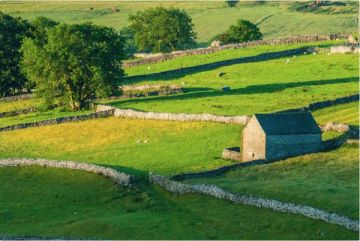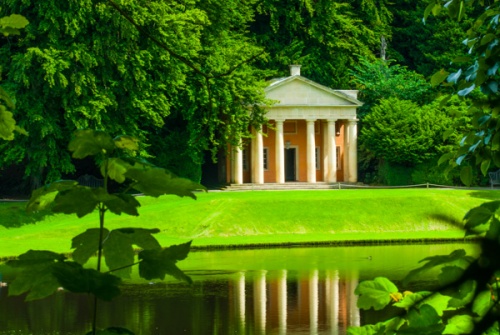
In 1722 John Aislabie retired to his estates at Studley Royal, near Ripon, after the South Sea Bubble scandal erupted during his tenure as Chancellor of the Exchequer. For the next 20 years, he worked to create the best water garden in England, perhaps in Europe. Lakes, grottoes, canals, and cascades join with classical temples and the ruins of medieval Fountains Abbey to provide an unforgettable landscape.
History
John Aislabie (1670-1742) inherited the Studley Royal estate in 1693 at the age of 23. He was just about to launch a political career that would see him rise to the very top and plummet just as quickly to the very bottom.
Aislabie's father George had 'married money' by wedding Mary Mallory, the daughter of Sir John Mallory of Studley Royal. John studied at Cambridge University and was elected MP for Ripon in 1695. He rose to become a Lord of the Admiralty in 1710 and Treasurer of the Navy in 1714. In 1718 he was named Chancellor of the Exchequer.
In that role, he helped push a bill through the House of Commons by which the South Sea Company would take over the national debt in exchange for government bonds. The South Sea Company collapsed in 1720 and a Parliamentary investigation found that Aislabie had received £20,000 in company stock in exchange for promoting the scheme.
He resigned his post as Exchequer in 1721 and was imprisoned in the Tower of London for 'dangerous and infamous corruption'. He did not stay long in the Tower, and after his release, he retired from public life and returned to Yorkshire where he devoted his time to creating one of Britain's great gardens on his family estate at Studley Royal.
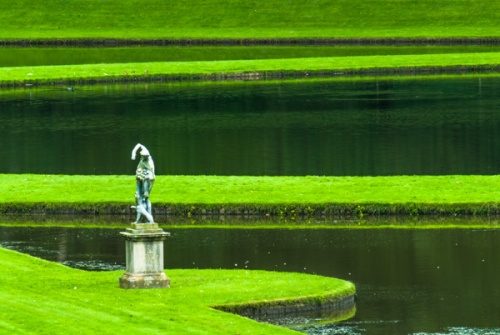
The roots of Studley Royal Water Gardens go back a few years before Aislabie was forced from political office. He began transforming Studley Royal around 1716, introducing a new, natural form of landscape gardening at odds with the 17th-century reliance on rigidly formal designs.
Aislabie wanted to create, not a garden, but a picturesque landscape that would impress his visitors. He used the entire wooded valley of the River Skell as a vast canvas to create a water garden on a huge scale, incorporating the natural landscape features of the valley into a carefully designed landscape garden and arranging garden features at strategic locations around the valley.
John Aislabie and his son William created a landscape designed to offer viewpoints and vistas centred on carefully placed objects such as classical statues and garden follies that acted as focal points. In 1767 William Aislabie bought the neighbouring ruins of Fountains Abbey and made them a part of the garden landscape. The medieval ruins acted as the ultimate 'eye-catcher', a distant picturesque crumbling ruin to draw the viewer's gaze.
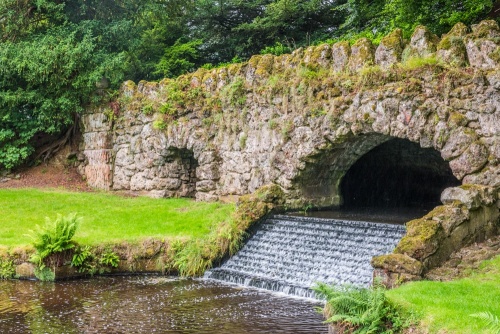
Garden features include Anne Boleyn's Seat (sometimes called 'Surprise View'). The neo-classical garden seat offers a sudden and dramatic view down the valley to the abbey ruins. On the valley bottom is a long canal flanked by grassy banks. The canal runs into a semi-circular lake called Half Moon Pond, a completely circular lake called, not surprisingly, Moon Pond, and a triangular lake known as Crescent Pond.
Beside these waterways are a variety of carefully arranged sculptures, designed to draw the viewer's eye. The wooded valley rises up to the High Ride, a broad track leading to a Gothic folly known as the Temple of Fame (c. 1770). High on the west side of the valley are the Octagon Tower (c. 1735) and the Banqueting Hall (c. 1728).
Another feature is How Hill Tower, a folly in the style of Sir John Vanbrugh. It is entirely possible that Vanbrugh, the architect of Castle Howard, influenced Aislabie's tower, for the men met during Aislabie's political career.
The water garden as we see it today is much as it was when William Aislabie died in 1781.
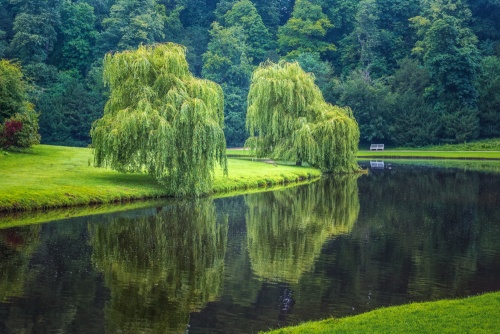
The Deer Park
Just outside the water garden is the ancient deer park, home to over 600 deer. Also part of the Studley Royal Estate, is the historic church of St Mary's, Studley Royal (English Heritage), a lushly decorated Victorian church.
The abbey and water gardens can be visited on a combined admission.
Be warned: Fountains Abbey and Studley Royal is a very popular destination, and may be crowded, particularly during the summer months.
About Studley Royal Water Garden
Address: Ripon,
North York Moors,
Yorkshire,
England, HG4 3DY
Attraction Type: Garden
Location: Off the B6265
Website: Studley Royal Water Garden
Email: fountainsabbey@nationaltrust.org.uk
National Trust
Location
map
OS: SE275700
Photo Credit: David Ross and Britain Express
POPULAR POSTS
HERITAGE
 We've 'tagged' this attraction information to help you find related historic attractions and learn more about major time periods mentioned.
We've 'tagged' this attraction information to help you find related historic attractions and learn more about major time periods mentioned.
Historic Time Periods:
Find other attractions tagged with:
17th century (Time Period) - Anne Boleyn (Person) - castle (Architecture) - Decorated (Architecture) - John Vanbrugh (Person) - Medieval (Time Period) - neo-classical (Architecture) - Parliamentary (Historical Reference) - Victorian (Time Period) -
NEARBY HISTORIC ATTRACTIONS
Heritage Rated from 1- 5 (low to exceptional) on historic interest
Fountains Abbey - 0 miles (Abbey) ![]()
Studley Royal, St Mary Church - 0.1 miles (Historic Church) ![]()
Markenfield Hall - 1.7 miles (Historic House) ![]()
Workhouse Museum - 2.6 miles (Museum) ![]()
Courthouse Museum - 2.6 miles (Museum) ![]()
Ripon Cathedral - 2.7 miles (Cathedral) ![]()
Prison and Police Museum - 2.7 miles (Museum) ![]()
The Leper Chapel, Ripon - 2.9 miles (Historic Church) ![]()
Nearest Holiday Cottages to Studley Royal Water Garden:
More self catering near Studley Royal Water Garden



